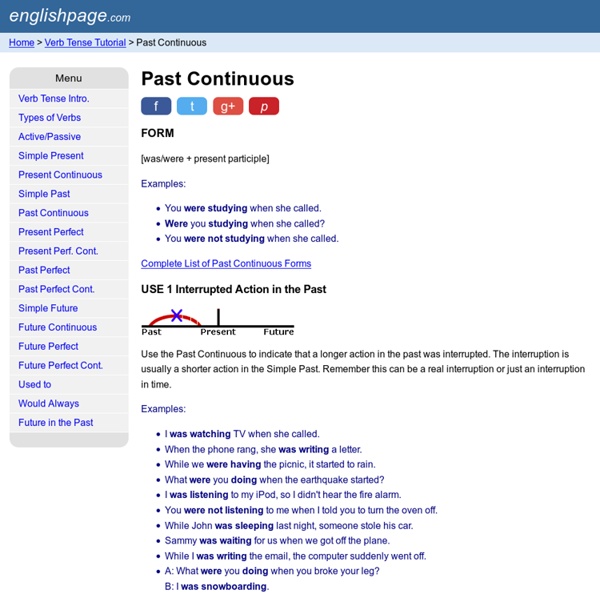Past Continuous
[was/were + present participle] Examples: You were studying when she called. Complete List of Past Continuous Forms USE 1 Interrupted Action in the Past Use the Past Continuous to indicate that a longer action in the past was interrupted. I was watching TV when she called. USE 2 Specific Time as an Interruption In USE 1, described above, the Past Continuous is interrupted by a shorter action in the Simple Past. Last night at 6 PM, I was eating dinner. In the Simple Past, a specific time is used to show when an action began or finished. Last night at 6 PM, I ate dinner. USE 3 Parallel Actions When you use the Past Continuous with two actions in the same sentence, it expresses the idea that both actions were happening at the same time. I was studying while he was making dinner. USE 4 Atmosphere In English, we often use a series of parallel actions to describe the atmosphere at a particular time in the past. Example: USE 5 Repetition and Irritation with "Always" While vs.
Grammar Awareness TEFL NEED pls?
Anonymous: Thaaaaanks Sir for the Grammar Awareness, was a success.!!! Am ONLY left with the last two questions to answer then am done with is course.I have come along way on this course and don't want to fail, pls kindly help Sir. I was emailed the following below as guide but am still clueless. Beginner1. Introductions2. Elementary1. Pre-intermediate1. Intermediate1. Upper- intermediate1. Advanced1. pls help, thanks
Pasado Continuo – (Past Continuous)
El Pasado Continuo, es un tiempo verbal que describe acciones que estaban siendo realizadas en un momento del pasado al que se hace referencia y que luego continuaron, por ejemplo: Yesterday he was studying English. Ayer él estaba estudiando inglés. (Comenzó a estudiar antes de ese momento y continuó estudiando posteriormente) John was playing tennis at 10 a.m. John estuvo jugando tenis a las 10 a.m. El Pasado Continuo se construye con el verbo auxiliar “to be” en su forma pasada y el verbo principal en infinitivo con la terminación ING: Observa que la forma negativa se construye colocando la partícula NOT después del verbo TO BE. También se puede utilizar este tiempo verbal para relatar dos acciones que sucedieron en el pasado y que una de ellas ya se ha completado. When I left, he was studying the lesson. They were singing when I broke the window.
Grammer?
Anonymous: I am on my last attempt with the following questions. I have included the answers I think are correct and the examiners comments, I have really tried and I just can'y work out the correct answers. ny help would be great. Thanks For each of the following four sentences:(i ) Identify the verb phrase.(ii) Name the structure. Examples: I start work at seven every morning. I was living in Peru at the time. I went to Thailand last year to teach. Answer: Comment: (iii) Unfortunately this is not the past participle form of the verb. She can speak Mandarin. Comment: (ii) Yes, it is a modal structure in the present simple. He's been a teacher for ten years. Comment: (i ) is now correct. The school was founded in 2002. Comment: (ii) It is the past simple but note that it is the past simple passive.
Curso video pasado continuo (past continuous). tiempos verbales en inglés
El vídeo de inglés enseña el pasado continuo (Past Continuous) de los tiempos verbales en gramática. Este tiempo nos indica una acción que ocurrió en el pasado pero en una situación exacta y momento preciso. Normalmente este tiempo verbal se utiliza para la narración de hechos y descripción de actividades que ocurrieron utilizando el verbo en gerundio. Mostramos un diálogo relatando las malas experiencias que tuvo un personaje en unas vacaciones. El pasado continúo o Past Continuous está formado gramaticalmente de la siguiente manera: - to be (past) + verb + ing En el vídeo vemos como ejemplo una situación conflictiva, presentando la utilización del pasado contínuo en las expresiones en donde el personaje se queja del viaje que realizó en sus vacaciones, en esta forma gramatical observamos la conjugación en primera persona, tiempo pasado del verbo "to be" y a continuación el verbo en infinitivo, agregando la terminación “ing”, es decir, el verbo en gerundio. Sobre el curso
Related:
Related:



